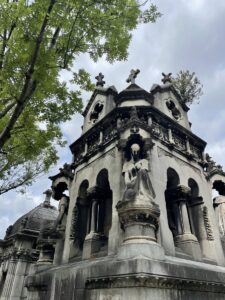At first glance, cemeteries often leave a melancholic and gloomy impression on people. However, the true essence of a cemetery is quite the opposite. Not only do they act as living relics reflecting the culture and history of their environment, but they also bring people together by offering a space to commemorate the dead – offering an air of serene remembrance. Or perhaps confrontation with our mortality is conducive to fostering community, as we all acknowledge our combined fate.

This week I had the opportunity to visit Cimetiere du Pere-Lachaise, one of the world’s most visited and legendary necropolises in the world. The visit was characterized by a breathtaking amalgam of antique tombs, modern headstones, and ornate mausoleums. Walking through this labyrinth of a cemetery, I couldn’t help but think of Milan Kundera’s Immortality, in which he suggests that when a person passes and continues to live on in the memories of others, they are immortal. I had the overwhelming sensation that my presence, and the presence of others, was giving life (hence, immortality) to those resting around me.

This got me thinking on the utility of memorialization and burial – why is it important to have a physical manifestation of oneself after death? Why has this practice surfaced in cultures all around the world and seemingly since the beginning of human history? In my search for these answers, I began with investigating the effects that grief and bereavement have on the brain. The study Gundel et. al (2003) found that picture and word factors targeting grief affects the posterior cingulate cortex, medial/superior frontal gyrus, and the cerebellum. The picture factor specifically activated the cuneus, superior lingual gyrus, insula, dorsal anterior cingulate cortex, inferior temporal gyrus, and fusiform gyrus, while the word factor uniquely activated the precuneus, precentral gyrus, midbrain, and vermis. This is to say that grief has an extensive effect on many neural processes and is mediated by a distributed neural network. This study shows that grief affects the brain’s processing of episodic memory, visual imagery, autonomic regulation, and many other functions. Considering this pervasive effect, it is no surprise that grief has been shown to impact one’s health – after all, dying by way of a “broken heart” is no cliché.
Establishments such as cemeteries help to mitigate the negative effects that grief has on a person. These monuments extend the memory of the person whose passed, helping to keep it alive, and ultimately make immortality a reality.

References
Gündel, H., O’Connor, M. F., Littrell, L., Fort, C., & Lane, R. D. (2003). Functional neuroanatomy of grief: an FMRI study. The American journal of psychiatry, 160(11), 1946–1953. https://doi.org/10.1176/appi.ajp.160.11.1946

Interesting about the effects of grief. Would be interesting if there are any studies about “best” mourning practices – very subjective and influenced by culture, but what broad practices are best in helping us deal with the loss of someone?